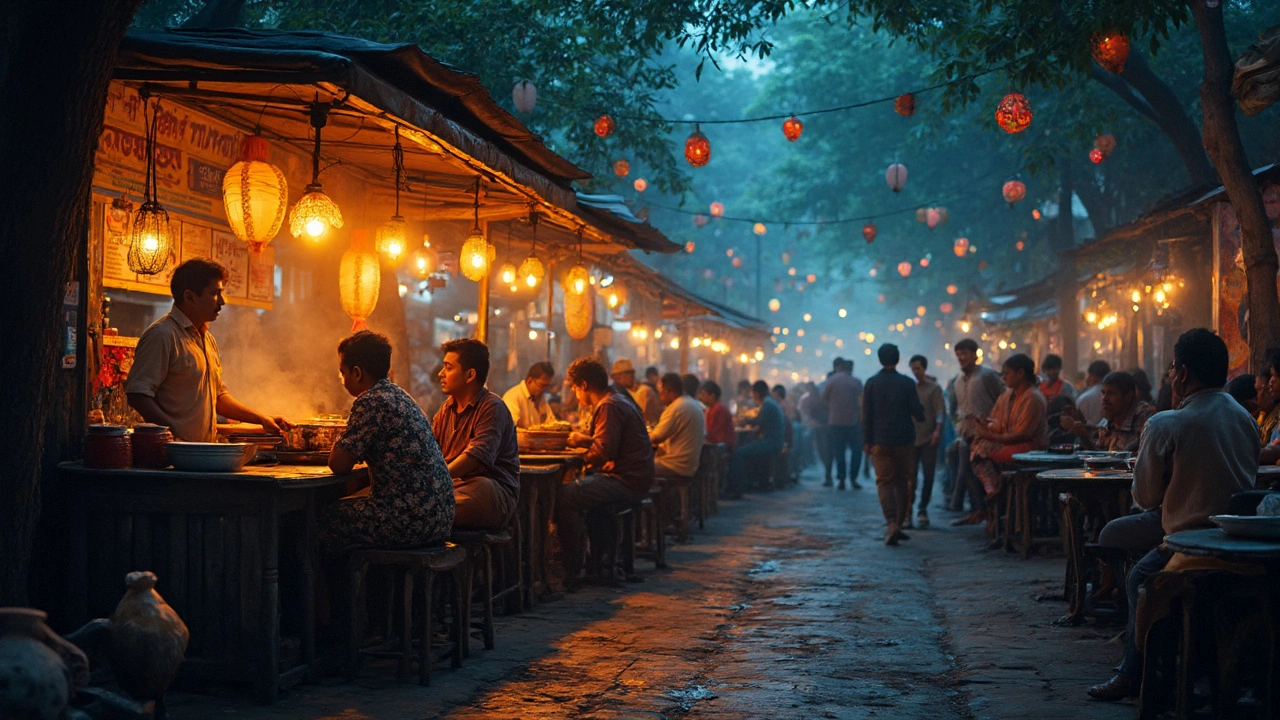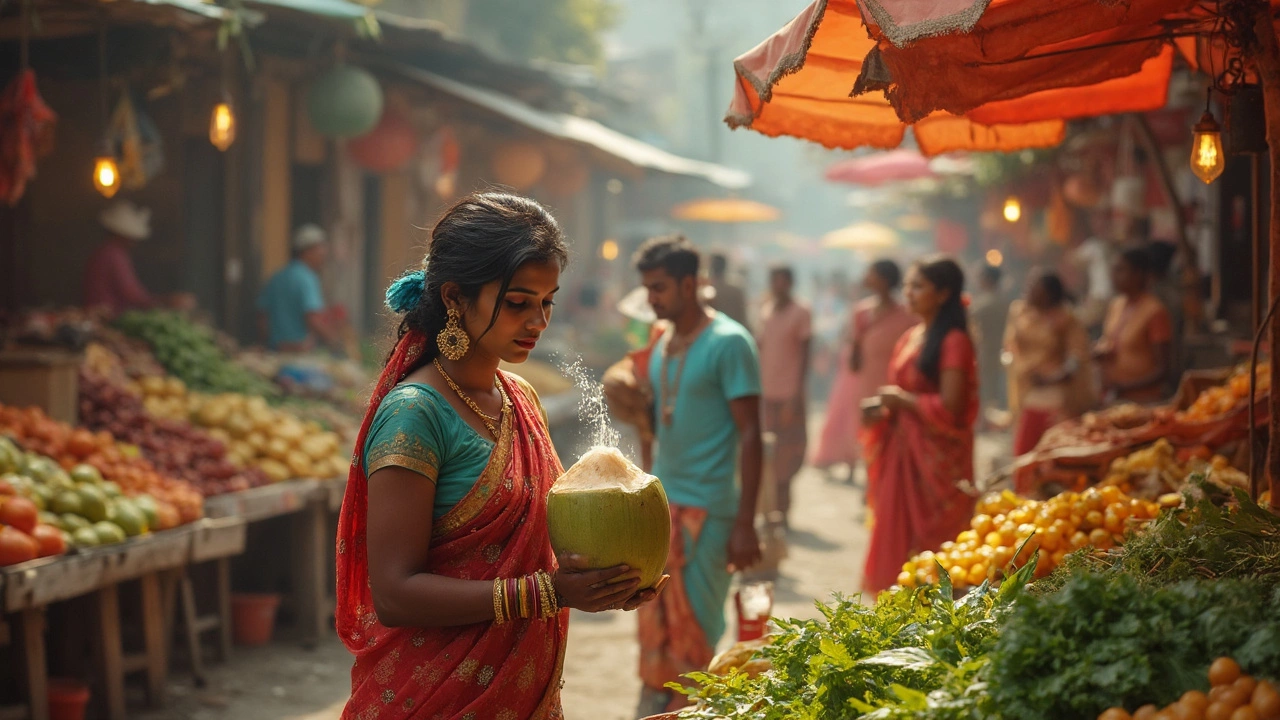There's something irresistible about Indian vegetarian dishes, right? The spices, flavors, and variety can quickly make you fall in love. But let's be real, the thought of dealing with an upset stomach, especially diarrhea, isn't exactly fun. Been there, worried about that!
When it comes to tackling this, a bit of know-how goes a long way. Start with picking the right places to eat. I mean, a bustling restaurant with locals streaming in is often a good sign. They've got fresh food turning over all the time.
Now, keep an eye out on that street food temptation. It's tempting, but try going for stalls that stick to cooked items. Trust me, piping hot means less risk. And if you're thirsty, steer clear of tap water. Bottled or filtered is the safe bet; your tummy will thank you.
- Understanding the Indian Food Scene
- Choosing Clean and Safe Eateries
- Making Smart Food Choices
- Importance of Staying Hydrated
- Packing Essential Health Supplies
Understanding the Indian Food Scene
India's food scene is a colorful tapestry of tastes and traditions. It's not just about street food chaos or spice galore; it's a vibrant mix of regional cuisines, each with its unique flair. Whether you're savoring a vegetarian Indian dish like a hearty Punjabi chole or a delicate dosa from the South, it's a flavor journey on its own.
One thing you’ll quickly notice is the strong emphasis on spices. According to a 2024 survey by the Indian Culinary Institute, about 98% of Indian households use whole and ground spices daily. They not only punch up the taste but often aid digestion too. So, spices and health are kind of a package deal here.
The Times of India quotes Chef Vikas Khanna, "Indian cuisine teaches us the art of balance. Yes, it's spicy, but there's a method that ensures it soothes more than it challenges our palate."
Another key thing? Freshness. The food doesn’t sit longer than it needs to, especially at popular places. In bustling cities like Mumbai or Delhi, vendors often cook in full view of customers – a small assurance to us foodies that the meal is handled right.
But wait, here's a straightforward tip: Know your thali. It's not just a platter, but a symphony of flavors. A typical vegetarian thali might include dal, vegetable curries, rice, and roti, giving you a little bit of everything.
- Stick to Busy Spots: The more people you see eating there, the fresher (and safer) the food likely is.
- Check for Cleanliness: Look out for hygiene levels. Clean counters and well-groomed staff often mean better food safety.
So, while diving into India’s culinary landscape, a little awareness goes a long way in ensuring you enjoy without any, well, nasty stomach surprises. Happy munching!
Choosing Clean and Safe Eateries
Finding a clean and safe place to eat in India might seem daunting at first, but it’s definitely doable with a few handy tips. First things first: when looking for a spot to eat, busy places are generally a safe bet. The constant flow of customers usually means the food is fresh and dishes aren’t left sitting around.
Next, take a glance at the hygiene practices. An eatery where the staff is wearing gloves and hairnets is usually a good sign. And don't be shy about checking out the cleanliness of the tables and kitchen if it's visible. The cleaner the spot, the better your odds of avoiding anything unpleasant.
As you explore, be mindful of where locals are eating. They've got the experience to know what's safe. Another tip is to start conversations with them about their favorite vegetarian Indian dishes and recommendations for eateries. A friendly chat can provide some surprisingly good insider advice.
When you're at the menu, opting for freshly cooked meals can reduce your risk. Foods that are steamed, boiled, or fried are generally safer than raw items. It's also smart to ask about any specific ingredients if you have dietary restrictions.
Remember, if you're trying street food, the same rules apply. Look for freshly made items and try to catch them during peak times when there’s high traffic and quick turnover. Besides, who doesn't enjoy eating where everyone's excitedly queuing up?

Making Smart Food Choices
Diving into the world of vegetarian Indian dishes is like a feast for the senses! But, it’s equally important to make choices that keep your stomach happy. Let’s talk about a few smart moves you can make while exploring the delicious cuisines of India.
First off, opt for dishes that are cooked fresh. Items like paneer tikka or masoor dal that are made to order tend to be safer than pre-cooked and reheated foods. The cooking process itself helps kill off any potential germs.
- Avoid raw salads and fresh-cut fruits from street vendors. Though they look healthy, they might be washed in local water, which can sometimes be a bit iffy.
- Packed snacks and beverages from reputable brands are your friends. These are generally safe because they’re sealed and processed.
- Feel like having a sweet treat? Go for items that are cooked like gulab jamun over raw options like those tempting lassi drinks unless made in front of you.
If you’re venturing for a really local experience and find yourself at a smaller eatery, be bold and ask what’s freshest. The staff usually know what was whipped up in the kitchen most recently.
Here's a quick look at safe food choices often available across India:
| Food Item | Why It's a Good Choice |
|---|---|
| Masala Dosa | Cooked thoroughly, served hot |
| Aloo Paratha | Crispy and hot, minimal risk of contamination |
| Chole Bhature | Served fresh, always a local favorite for a reason |
Remember, the magic of Indian food is in its diversity. Staying smart about what and where you eat ensures you enjoy every bite without any unwelcome surprises. Happy munching!
Importance of Staying Hydrated
Keeping hydrated is probably one of the simplest yet most crucial things you can do while traveling around India. Seriously, it's not just about keeping thirst at bay, but also your overall health in the heat. Plus, it’s a big help in avoiding that dreaded diarrhea.
Let’s face it, India can get pretty hot, especially in the summer months. It's essential to drink enough fluids, but you want to make sure they're safe. Here’s where bottled water becomes your best buddy. Go for brands you trust and always check that the seal isn’t broken. Sounds obvious, but it’s easy to overlook when you're busy.
If you're a fan of juices, just ensure they're fresh and made with filtered water. The same goes for ice, which can be a hidden threat. It's safer to skip the ice in drinks unless you know it's made from clean water.
- Diarrhea prevention top tip: Avoid tap water. Always opt for bottled or filtered water.
- Bring along a reusable water bottle with a built-in filter. Handy and environmentally friendly!
- Replenish your electrolytes. You can grab electrolyte packets from local pharmacies. They’re small, cheap, and super effective.
Let’s not forget about food. A lot of Indian dishes are watery, like the famous sambhar or rasam. These are generally safer options for staying hydrated while enjoying the local flavors.
Travel tips India: Keep a lookout for fresh coconut vendors. Coconut water is not only refreshing but packed with nutrients and quite easy on the stomach.
Staying hydrated doesn’t have to be a chore. With just a bit of planning, you can focus more on enjoying the incredible vegetarian Indian dishes and less on worrying about any stomach woes. So, drink up and stay healthy!

Packing Essential Health Supplies
When you're off to India, especially if you’re excited about the local vegetarian Indian dishes, knowing what health supplies to pack can save your trip from an unexpected bathroom marathon. Here's what to stash in your travel kit:
- Probiotics: These are your tummy's best pals. They help keep your gut healthy and can minimize the chances of getting diarrhea from unfamiliar foods.
- Oral Rehydration Salts (ORS): Hydration is key if you catch a bug. ORS packets can be lifesavers when dealing with dehydration.
- Antidiarrheal Medications: Over-the-counter options like loperamide can keep things under control until you find a pharmacy.
- Hand Sanitizer: Before you dig into those delicious meals, a quick squirt of sanitizer can cut down on germ risks.
- Water Purification Tablets: If you find yourself without bottled water, these tablets can make local water safer.
Travel insurance is also a smart move. It's like a safety net if things go really off-track health-wise. Some insurance even covers minor health supplies, so check the details.
Don’t try new meds on the road; get familiar with them beforehand. This advice might seem a bit old-school, but hey, better safe than sorry, right?
